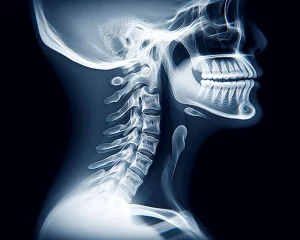
Is Straight Neck a Disease? A Small Detail That Makes a Big Difference in Scoliosis Treatment
Straight neck, a term we’ve been hearing more and more lately, especially with the increase in technology use. While it’s often perceived as a disease, the situation is actually a bit different. So, is straight neck really a disease, or is it a postural disorder brought on by modern life?
In this article, we’ll answer all your questions about straight neck, detailing its causes, symptoms, and, most importantly, its solutions.
Straight Neck: What It Is and Why It Isn’t a Disease
A healthy cervical spine has a natural “C” curve. This curve helps to distribute the weight of the head evenly across the neck and back muscles. Straight neck (loss of cervical lordosis), on the other hand, is the condition where this natural “C” curve flattens or even reverses.
This condition is not considered a disease on its own. Rather, it’s a consequence of another issue, specifically poor posture or muscle imbalance. Modern lifestyle habits, such as prolonged sitting at a desk, looking down at smartphones, or hunching over a computer, can alter the natural structure of the cervical spine, leading to this condition.
What Are the Symptoms of Straight Neck?
Straight neck may not always show obvious symptoms. However, as the condition progresses or muscle tension increases, the following symptoms may appear:
Neck and Shoulder Pain: This is the most common symptom. The pain can spread to the shoulder blades and upper back.
Headaches and Migraines: Especially tension-type headaches, which can result from tight neck muscles.
Numbness/Tingling in Arms and Fingers: When the nerves in the neck are compressed, you might experience a loss of sensation in your arms and hands.
Dizziness and Balance Issues: Although rare, this can occur if the neck muscles affect the inner ear balance organs.
Limited Neck Movement: Difficulty moving the neck from side to side or up and down.
What Causes Straight Neck?
Straight neck is usually caused by a combination of several interconnected factors:
Poor Posture: Sitting incorrectly at a desk or constantly hunching forward.
Technology Use: Known as “text neck,” this involves keeping the neck bent forward for long periods while using a smartphone or tablet.
Sedentary Lifestyle: A lack of exercise can weaken the neck and back muscles.
Stress: Stress causes tension in the neck and shoulder muscles, which negatively affects posture.
Incorrect Sleeping Position: Using a pillow that is too high or too low can disrupt the neck’s curve.
How to Prevent and Treat Straight Neck
Straight neck can be managed and its symptoms alleviated with the right methods. The most effective approach is an exercise and posture correction program guided by a physical therapist.
Exercises: Exercises that strengthen the neck, back, and shoulder muscles can support the spine’s natural curve. Chin tucks and shoulder blade squeezes are particularly beneficial.
Posture Awareness: Frequently check your posture throughout the day. Your ears should be aligned with your shoulders, and your shoulders should be back.
Ergonomic Adjustments: Make sure your desk, computer screen, and chair are ergonomically suited for your neck.
Sleeping Habits: Choose a pillow that supports the natural curve of your neck. Lying on your back or side is recommended.
Professional Help: In cases of severe pain and numbness, consulting a doctor or physical therapist is the best course of action.
Frequently Asked Questions
Yes, the neck curve can be significantly improved with the right exercises, posture correction, and lifestyle changes. However, the complete recovery process varies from person to person.
Straight neck can increase the risk of a herniated disc by putting more pressure on the vertebrae. Therefore, it's crucial to take the condition seriously and take the necessary precautions.
Bring the screen to eye level and avoid bending your head forward. Take a break every 20-30 minutes to do some neck-stretching exercises.
Orthopedic pillows that fill the space of the neck, being neither too high nor too low, are recommended.
